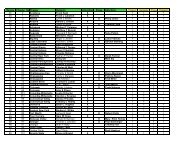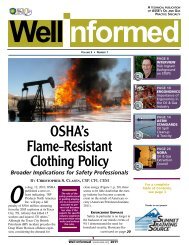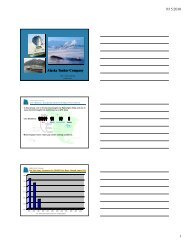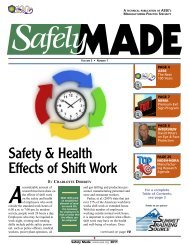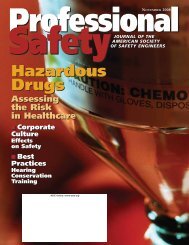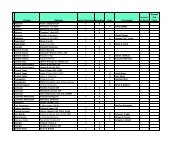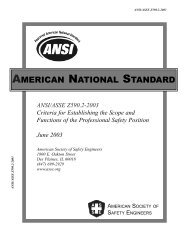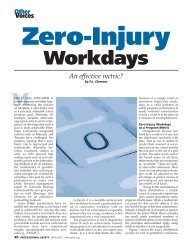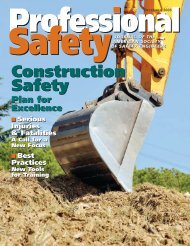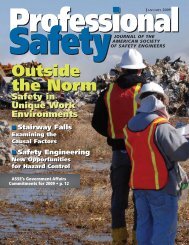Safety 2008 - ASSE - American Society of Safety Engineers
Safety 2008 - ASSE - American Society of Safety Engineers
Safety 2008 - ASSE - American Society of Safety Engineers
Create successful ePaper yourself
Turn your PDF publications into a flip-book with our unique Google optimized e-Paper software.
Selecting an ErgonomicsRisk Assessment ToolBy David BrodieWhen assessing ergonomic stressors, the use <strong>of</strong> quantitative or semiquantitative evaluationtools provides the evaluator with numeric output with which s/he may evaluatethe risk for the development <strong>of</strong> MSDs for a given job. This output may also allow theevaluator to compare relative risk <strong>of</strong> multiple jobs or tasks, thereby identifying jobs ortasks that pose the greatest risk. This may help set priorities for ergonomics efforts.These tools may also provide the evaluator or designer with recommended limits to thestressors present in a job, task or job design. These limits may be used to help reduce therisk to safe levels. Furthermore, the results may be used to compare the same job or taskbefore and after an intervention is implemented.Given the large number <strong>of</strong> ergonomics risk assessment tools available in books, peerreviewedliterature and from various other sources, one should consider these three recommendationswhen selecting a tool.1) Read original articles and/or documentation to understand the design, use andintent <strong>of</strong> the ergonomics tool.One common error is using the tool incorrectly and for the wrong purpose. When anergonomics tool is developed, it is <strong>of</strong>ten for a specific purpose, such as evaluating a specifictype <strong>of</strong> activity (e.g., lifting, posture, hand activity) or a specific work environment. Thevalidity <strong>of</strong> the tool may be compromised if used outside <strong>of</strong> these conditions, so it is importantto know these boundaries.One challenge is that there is insufficient information to determine the exact way inwhich the tool should be implemented. Also, it is <strong>of</strong>ten impossible to determine what to dowhen attempting to apply the tool in suboptimal conditions (what do you do when a novelsituation develops?). Furthermore, the peer-reviewed articles on a given tool <strong>of</strong>ten focus primarilyon the theory and design <strong>of</strong> the tool, not its practical application. This leads to thesecond recommendation.2) Establish assumptions and decision criteria for the tool.To consistently and effectively apply an ergonomics tool, it is important to interpret thedesign and approach <strong>of</strong> the tool and develop appropriate strategies to implement it consistentlyand accurately. Once the tool’s boundaries are understood, it is necessary to developdecision criteria to ensure that the tool is always used within these boundaries—and thatusers <strong>of</strong> the tool will achieve consistent outcomes (i.e., reliability).If a tool is used consistently, then the output <strong>of</strong> the tool can be used to measure such conditionsas baseline exposure, differences in exposure and changes in exposure. With thislevel <strong>of</strong> consistency, it is unnecessary to have a tool that has external validity (i.e., correlationwith injury causation). Instead, the tool simply provides a means <strong>of</strong> accurately measuringchanges in exposure, which is <strong>of</strong> value in itself. If the tool has been validated throughresearch such that it has external validity, then the value <strong>of</strong> the measures is even greater.3) Provide sufficient time for training and practice.One critical factor in achieving accurate, consistent output from an ergonomics riskassessment tool is practice. Once an individual is trained on the tool’s design and boundaries,and on the process and decision criteria for its implementation, then it is necessary topractice, practice and practice again.An analyst should be able to explain the theory <strong>of</strong> a tool, discuss the measures and methodsthat are used to apply the tool, describe its output and interpret that output beforeapplying it in real-world situations. This does not mean that a person cannot use a toolwithout this absolute level <strong>of</strong> knowledge; instead, this means that a person should practiceand learn about the tool in a work setting, but refrain from using the outputs until positivethat the process used is accurate. In this interim stage, it is helpful to discuss the implementation<strong>of</strong> the tool with a mentor or long-time user. Ergonomics community e-mail lists areone way to contact experienced ergonomists. In addition, the Board <strong>of</strong> Certification inPr<strong>of</strong>essional Ergonomics’ website (www.bcpe.org) provides a listing <strong>of</strong> pr<strong>of</strong>essional ergonomistswho may be willing to provide mentorship in this process.David M. Brodie, M.S., CPE, is director <strong>of</strong> ergonomics services for Atlas Ergonomics LLC in Raleigh, NC. Heis a member <strong>of</strong> <strong>ASSE</strong>’s North Carolina Chapter, the Industrial Hygiene, Healthcare and Transportation practicespecialties and the Ergonomics Branch. This article is adapted from his presentation at <strong>ASSE</strong>’s <strong>Safety</strong> <strong>2008</strong>.28 PROFESSIONAL SAFETY AUGUST <strong>2008</strong> www.asse.orgAll symptoms were resolvedwithin 2 weeks and have not, todate, recurred.Clearly, ergonomic implicationsshould be consideredwhen purchasing pipettes.Obtain sample pipettes andhave workers conduct a comfortand accuracy trial beforemaking a final purchasingdecision. Then, periodicallyrevisit the literature to learnabout innovative new designs.Glassware: Flasks,Beakers & Test TubesWhen deciding what type <strong>of</strong>flasks and beakers to use orpurchase, first consider thecontainer’s liquid contents. Forexample, plastic beakers weighless than glass but wouldbe inappropriate for acids.Grasping a traditional beakerrequires force between thethumb and palm/fingertips.Because the hand is open, forceis required for grasping, combinedwith forearm rotation toa palm-down position, associatedwith pouring. A singlehandlebeaker would allow fora preferred power grasp.NIOSH recommends a handlediameter <strong>of</strong> 1.25 to 2 in. forpower tasks (NIOSH &Cal/OSHA, 2004, p. 5). Whileforearm rotation would still benecessary for pouring, forcerequirements would be reducedthanks to improved coupling(grip). For large volumeand/or frequently handled liquids,dispensers with a spigothelp eliminate awkward pouringpostures.When evaluating ergonomicimplications for glassware inthe laboratory, consider testtube handling. Again, the frequencyand type <strong>of</strong> use isimportant. For frequent use,a pump-activated, definitivemeasuredispenser can reduceawkward wrist postures andforearm rotation associatedwith filling test tubes. Squeezebottles may be used for sometasks (Humantech Inc., 2000,pp. 3-12). Automated loadersdecrease the frequency andduration <strong>of</strong> manually handlingindividual tubes, thereby elim-



